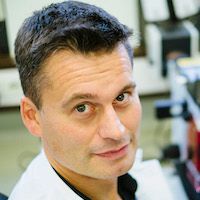Researchers Leverage Stem Cell Interaction to Spark Oligodendrocytes
A team of researchers has successfully created oligodendrocytes from human and rodent cells.

Patrick Kury, PhD
New research could help point a way forward to using stem cells to generate oligodendrocytes in patients with multiple sclerosis (MS).
The study, by a team of scientists in Germany, Great Britain, and Chile, is the latest sign of hope that stem cell therapy could one day be used to trigger remyelination to counter MS.
At issue in the new study are adult neural stem cells (NSCs). These cells have the potential to turn into oligodendrocytes, which support the insulation of the axons in a patient’s central nervous system. However, in reality, this repair process is typically are too inefficient to effectively counter MS.
The researchers in this study wondered if the process could be helped by signals from other stem cells. They decided to look at mesenchymal stem cells (MSCs), which are found in the bone marrow, and which had previously been shown to have the capability to signal the differentiation of adult neural stem cells.
“MSCs have been studied in many conditions and diseases as they appear to carry quite a high regenerative potential,” Patrick Küry, PhD, a co-author on the study and a professor in the Department of Neurology at Heinrich Heine University, in Düsseldorf, told MD Magazine.
So far, that potential had been demonstrated in rodent models, mainly rat cells, according to Küry.
In their study, Küry and colleagues were able to show that not only could the NSC/MSC interaction be used to generate myelin repair in rats; it could also be effective at triggering the maturation of human NSCs into oligodendrocytes in human cells in a lab.
Thus, the study marks an important step forward for stem cell research as it relates to combatting the effects of MS.
A co-author on the new study, Janusz Jadasz, PhD, was the first author on the first study that described the NSC-MSC communication.
Despite the positive results in the new study, Küry suggested a lot of repetition and verification needs to take place to prove the efficacy and effectiveness of the treatment.
“[The] next steps are to determine how far human MSC derived factors can promote oligodendrogenesis of human NSCs,” Küry said. “This includes more sophisticated assays looking at myelination in neuron/glia cocultures and then on the long-term to what degree such stimulated human NSCs could facilitate myelination in suitable in vivo models (relevant for demyelination in multiple sclerosis for example).”
Researchers also have much work to do to unpack how exactly the positive effect occurs, assuming it’s borne out in further research. Kury said his team is currently working to find out what the “active ingredients” are in the interaction between MSCs and NSCs.
“We assume that factor/compound cocktails account for the observed effects, which makes the identification difficult and time-consuming,” Kury said. “But then a detailed description of such active components is definitely necessary for meaningful biomedical translation as opposed to critical stem cell transplantation approaches.”
The study, “Human mesenchymal factors induce rat hippocampal- and human neural stem cell dependent oligodendrogenesis,” was published online in the journal GLIA.
Related Coverage
Pediatric Radiologically Isolated Syndrome Brings on MS Faster
Despite Benefits, MS Patients Underutilize Exercise
Computational Analysis Supports "Single Disease" MS Theory